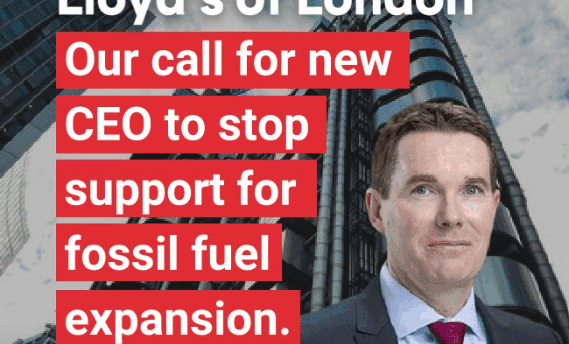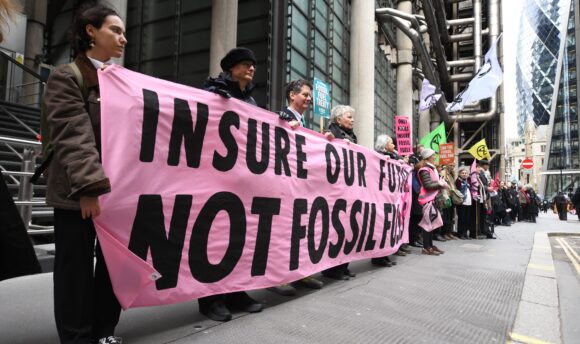Tokyo, 31 October 2023
Dear IAIS Executive Committee Chair Saporta and Vice Chair Ariizumi:
CC: IAIS Executive Committee, Climate Risk Steering Group Chair and Vice Chair, and Secretariat
We write to you today from dozens of climate, environment, and consumer protection organisations, as you prepare for the IAIS annual meeting, to express our deep concern that the IAIS is taking insufficient action to address the risks of climate change and nature loss and their implications for the insurance sector.
IAIS must act because the industry is driving climate risk and financial system vulnerabilities
August 2023 marked 50 years since the insurance industry first warned about the increasing risks of climate change (1). Meanwhile, the climate crisis has become a grim reality for billions of people – most seriously for poor and marginalised communities in parts of the global North and throughout the global South that have contributed the least to climate change. July 2023 was the hottest month in recorded history and unprecedented heatwaves, wildfires, and floods have ravaged countries around the world.
Since 2017, the insured losses from natural disasters (mostly human-made climate disasters) averaged $110 billion per year, more than double the average amount in the previous five years (2). In response, reinsurance and primary insurance rates have increased rapidly, while the industry warns that growing parts of the world other countries risk becoming “uninsurable.” (3) As California’s former insurance commissioner, Dave Jones, warned recently, “I do believe we’re steadily marching towards an uninsurable future, not only in California, but throughout the United States.” (4) In Europe, the European insurance supervisor (EIOPA) estimates that only about a quarter of climate-related catastrophe losses are currently insured and this insurance protection gap could widen in the medium to long term as a result of climate change (5). Latin America and the Caribbean form one of the world’s most disaster-prone areas with damages exceeding 50% of GDP in the last few decades, yet has the lowest levels of insurance coverage, particularly among households (6). This march toward greater and greater regions without insurance coverage creates serious risks for the communities and businesses whose risks the industry is supposed to manage. It also creates serious risks to the insurance industry itself.
Meanwhile, climate change mitigation is falling behind: greenhouse gas emissions from the energy sector reached a record amount in 2022 (7). Yet in spite of its powerful role as a global risk manager, the insurance industry is not using its influence to accelerate the transition from fossil fuels to clean energy. Instead, it is adding fuel to the fire by underwriting the continued expansion of oil and gas extraction. As noted by the U.S. Treasury Department in a June 2023 report on climate-related risks for the insurance industry, the U.S. insurance industry’s corporate bond and equities investment exposure to high GHG-emitting industries is approximately $439 billion, or 15% of those investments (8).
UN Secretary General António Guterres, civil society groups (9) and other actors have called on the insurance industry to align underwriting and investments with the goals of the Paris Agreement, but none are yet Paris-aligned. Numerous insurance companies have adopted restrictions on their fossil fuel business, but it is difficult for any one insurer to adopt bold climate action in the interest of the industry and society as a whole under competitive pressure.
The Net Zero Insurance Alliance (NZIA), which was founded in 2021, was supposed to create a level playing field for a science-based transition of the insurance industry and a credible pathway to the 1.5 °C Paris Agreement goal. Yet under pressure from the fossil fuel lobby, under the pretence of anti-competition (10), 20 of the original 31 NZIA members have left the alliance and the NZIA abolished all material requirements for its members. This poses great risks for an orderly transition in the insurance sector, and requires regulators to urgently clarify scope for collective industry action in the public interest.
Meanwhile, actuaries – who provide crucial risk assessments for the insurance industry – are sounding the alarm about the extreme inadequacies of current risk modelling and management practices. Analysis published by the Institute and Faculty of Actuaries (the UK’s professional association for actuaries) found that:
- The climate-scenario models commonly used in financial services are significantly underestimating climate risk, meaning assessments of likely damages are way off.
- More realistic models show that carbon budgets may be smaller than anticipated and risks may develop more quickly.
- Most current regulatory scenarios do not reflect experience or fully capture risk, are not realistic, and don’t account for tail events (11).
The Financial Stability Board – the international body that monitors and makes recommendations about the global financial system – and the Network for Greening the Financial System have also acknowledged the significant limitations of climate scenario analysis as it currently stands (12). These limitations have led to benign results of the climate scenario analyses conducted to date and, alarmingly, have served as one of the reasons for the lack of decisive actions to address climate-related risks. At the same time, supervisors also agree that a delayed and disorderly transition is itself a major risk for financial stability.
Current global insurance regulations are patchy at best
Unfortunately, to date the global regulatory environment on insurance and climate-related financial risk is patchy at best, and nature-related risk still needs to be integrated into the regulatory framework. Preliminary findings of WWF’s assessment of Sustainable Financial Regulations and Central Bank Activities (SUSREG) in 2023 reveals that insurance supervision is falling short in Asia-Pacific and Latin Americas mega-biodiverse countries, resulting in high exposure to nature-related risk. The top three highest emitting countries (China, USA, and India) align with less than 25% of the SUSREG climate-related insurance supervision criteria, a stark contrast to their significant carbon emissions. All of this points to the need for the IAIS to strengthen standards and create a level playing field.
For example:
- The European Union’s insurance regulatory regime, known as Solvency II, began an update in 2021 to, among other changes, require stronger sustainability risk management by (re)insurers, including climate scenario analyses. However, as mentioned above, climate change scenario analyses are subject to significant limitations so that they cannot be relied upon as prudential measures. Requirements on mandatory transition plans were introduced by the European Parliament (13), but remain subject to debate between the co-legislators. Further, the proposal does not include capital requirements to address stranded asset risk (14).
- Although insurance regulation is even patchier in the U.S., where individual states hold most of the insurance regulatory powers, federal policymakers and regulators are beginning to sound the alarm about the need for climate-related insurance regulation:
- The U.S. Treasury Department’s Federal Insurance Office (FIO) published a report on supervision and regulation of climate-related risks in June 2023, in which it noted that, though “there are nascent and important efforts to incorporate climate-related risks into state insurance regulation and supervision…efforts are fragmented across states and limited in several critical ways.” FIO outlined several ways in which the current regulatory environment badly needs updating within the context of an escalating climate crisis (15).
- Treasury Secretary Janet Yellen has warned of a “protection gap” across the insurance industry, estimating that only 60% of $165 billion in damages from climate disasters in 2020 were covered by insurers (16). In addition to inflicting major burdens on households and businesses, this “protection gap” also further raises financial stability concerns because of the possibility that more frequent catastrophic climate events could trigger losses that spread throughout the economy through defaults, delays, underpayments, and so on.
- New corporate climate disclosure rules in the European Union (CSRD) and California (SB 253) will start requiring, including many insurers, to disclose Scope 3 emissions.
- The CSRD requires all large companies and all listed companies (except listed micro-enterprises) to disclose information on what they see as the risks and opportunities arising from social and environmental issues, and on the impact of their activities on people and the environment (17).
- SB 253 requires companies with greater than $1 billion in annual revenues to file annual reports publicly disclosing their Scope 1, 2 and 3 greenhouse gas (GHG) emissions (18).
- The Monetary Authority of Singapore (MAS) released Guidelines on Environmental Risk Management for Insurers in December 2020 (19). These guidelines encompass a wide array of supervisory expectations related to environmental risks, such as climate change, biodiversity loss, pollution, and changes in land use. While the document does provide extensive guidance, most of the points it outlines are recommendations rather than mandatory requirements.The document mentioned expectations on both underwriting (e.g part of underwriting due diligence, monitor exposure and risk concentration, reflecting the risk into insurance premiums, etc) and investment activities (e.g ongoing monitoring, track environmental impacts of the portfolio, etc).
- Other major emerging economies in Asia such as China, India, and Indonesia have yet to implement robust insurance regulation and supervisory expectations that are in line with the Paris Agreement and Global Biodiversity Framework.
IAIS therefore must ensure supervisors implement the necessary prudential policy measures (see below) without further delays and in a harmonised way, recognising that climate change represents a systemic risk to financial stability.
The IAIS is acting on climate – but the scale and pace is insufficient
The IAIS is monitoring climate change as a key trend for the industry, has set up a disclosure workstream, and is conducting consultations on updates to its guidance related to climate change. These are good steps, but we need to see a faster and stronger response from the global network of insurance regulators in the face of the urgency of the climate crisis. The IPCC AR6 Synthesis Report has made clear that the world is approaching irreversible levels of global heating, and that it is now or never to take drastic action to avoid disaster (20). As the UN Secretary General has said, “2023 is a year of reckoning. It must be a year of game-changing climate action. We need disruption to end the destruction. No more baby steps. No more excuses. No more greenwashing.” (21)
Therefore, we call on the IAIS to:
- Take a precautionary approach to addressing environmental risk: Environmental risks – including both climate- and nature-related risks – are still a regulatory blindspot. Too much reliance is placed on historical data in addressing the risk, whereas by definition climate change and biodiversity loss are forward-looking, non-linear and irreversible phenomena. The IAIS must provide guidance to supervisors on how to include environmental risk into the supervisory framework, and reflect the risks in capital standards for the internationally-active insurance groups.
- Set expectations for credible transition plans: The IAIS should offer best practice guidance to ensure that insurance companies adopt transition plans with short-, medium- and long-term targets and aligned with credible 1.5°C pathways. Supervisors should review transition plans to understand an insurer’s levels of transition risk exposure. The guidance should follow the UN HLEG Standards on Net Zero Commitments by Businesses, Financial Institutions, Cities and Regions.
- Steer the industry away from exacerbating climate risk: The IAIS should offer best practice guidance for supervisors to ensure that insurers consider climate-related risk implications for their solvency position. The IAIS work on capital standards should be based on a precautionary approach to capital requirements reflecting the one-for-one rule (a dollar of capital held per dollar invested) for any investments in the fossil fuel sector across all asset classes (22).
- Don’t let contributors to the crisis get public support: The IAIS should propose rules to ensure that insurance companies that still underwrite or invest in new fossil fuel projects are excluded from managing or participating in any programs supported with public funds to insure climate risks and strengthen climate resilience.
- Rely on climate science: The IAIS must ensure supervisors mandate the use of established climate science when assessing possible impacts of the climate crisis, as opposed to the flawed prevailing economic models, which by design are not able to capture the consequences and non-linear complexity of climate change, and substantially underestimate its economic cost.
Sincerely,
- The Sunrise Project – international
- Ario Advisory – United Kingdom
- BreakFree Suisse – Switzerland
- Campax – Switzerland
- Climate Alliance Switzerland – Switzerland
- Climate Majority Project – United Kingdom
- Coal Action Network – United Kingdom
- Connecticut Citizen Action Group (CCAG) – United States
- E3G – international
- Ekō – international
- Finance Innovation Lab – United Kingdom
- Finance Watch – Belgium/European Union
- Green Faith – international
- Japan Center for a Sustainable Environment and Society (JACSES) – Japan
- Korea Sustainability Investing Forum (KoSIF) – Korea
- MARBE, S.A. – Costa Rica
- Mothers Rise Up, United Kingdom
- New Economics Foundation – United Kingdom & European Union
- New York Communities for Change – United States
- Oil and Gas Action Network – United States
- Oil Change International – United States
- Positive Money – United Kingdom, European Union & United States
- Public Citizen – United States
- Rainforest Action Network – United States
- Reclaim Finance – France
- Re-set – Czech Republic
- Revolving Door Project – United States
- ShareAction – United Kingdom
- Sierra Club – United States
- Texas Campaign for the Environment – United States
- WWF (Greening Financial Regulation Initiative) – Switzerland
- Urgewald – Germany
- 350 Colorado – United States
- 350 Wisconsin – United States
Notes
(1) Muenchener Rueckversicherungs-Gesellschaft, Hochwasser-Überschwemmung, August 1973, p. 7.
(2) Chandan Banerjee et al., “Natural Catastrophes and Inflation in 2022: A Perfect Storm” (Swiss Re, March 22, 2023), https://www.swissre.com/institute/research/sigma-research/sigma-2023-01.html.
(3) Reuters, “Disaster-hit Nations Must Rebuild Better or Risk Losing Insurance, Experts Say,” VOA News, October 13, 2017, https://www.voanews.com/a/disaster-hit-nations-rebuild-better-or-lose-insurance/4069809.html.
(4) “California Tries for a Different Path than Florida on Insurance,” POLITICO, September 10, 2023, https://www.politico.com/news/2023/09/09/california-florida-disaster-insurance-00114859.
(5) EIOPA, Policy options to reduce the climate insurance protection gap, Discussion Paper, April 2023.
(6) https://papers.ssrn.com/sol3/papers.cfm?abstract_id=1817233
(7) International Energy Agency, “CO2 Emissions in 2022 – Analysis,” IEA, March 2023, https://www.iea.org/reports/co2-emissions-in-2022.
(8) Federal Insurance Office, “Insurance Supervision and Regulation of Climate-Related Risks” (U.S. Department of the Treasury, June 2023), 59, https://home.treasury.gov/system/files/136/FIO-June-2023-Insurance-Supervision-and-Regulation-of-Climate-Related-Risks.pdf.
(9) See, e.g.: Finance Watch, “Open Letter: Banks and Insurers Must Account for Climate Risk,” July 7, 2022, https://www.finance-watch.org/publication/open-letter-banks-and-insurers-must-account-for-climate-risk/.
(10) Cynthia Hanawalt and Denise Hearn, “Of Pots and Kettles: Big Oil and the Anti-ESG Movement Are Accusing Banks of Running ‘Climate Cartels,’” Fortune, August 2, 2023, https://fortune.com/2023/08/02/big-oil-anti-esg-movement-banks-climate-cartels-politics-finance/.
(11) Sandy Trust et al., “The Emperor’s New Climate Scenarios” (Institute and Faculty of Actuaries, July 2023), https://actuaries.org.uk/media/qeydewmk/the-emperor-s-new-climate-scenarios.pdf.
(12) Financial Stability Board and Network for the Greening of the Financial System, “Current Climate Scenario Analysis Exercises May Understate Climate Exposures and Vulnerabilities, Warn FSB and NGFS,” November 15, 2022, https://www.fsb.org/2022/11/current-climate-scenario-analysis-exercises-may-understate-climate-exposures-and-vulnerabilities-warn-fsb-and-ngfs/.
(13) Finance Watch, “European Parliament’s Committee on Economic and Monetary Affairs Agrees Position on Solvency II,” July 18, 2023, https://www.finance-watch.org/press-release/european-parliaments-committee-on-economic-and-monetary-affairs-agrees-position-on-solvency-ii/.
(14) Isabella Salkeld and Caroline Metz, “What Is Solvency II and Why Does It Matter?,” ShareAction, accessed October 24, 2023, https://shareaction.org/news/what-is-solvency-ii-and-why-does-it-matter.
(15) Federal Insurance Office, “Insurance Supervision and Regulation of Climate-Related Risks” (U.S. Department of the Treasury, June 2023), 59, https://home.treasury.gov/system/files/136/FIO-June-2023-Insurance-Supervision-and-Regulation-of-Climate-Related-Risks.pdf.
(16) Christopher Condon, “Janet Yellen Sees a ‘Protection Gap’ between Insurance and Climate Change—Just 60% of 2020’s $165 Billion in Losses Got Covered,” Fortune, July 30, 2023, https://fortune.com/2023/07/30/janet-yellen-protection-gap-insurance-climate-change-disasters-treasury-secretary/.
(17) “Corporate Sustainability Reporting,” accessed October 24, 2023, https://finance.ec.europa.eu/capital-markets-union-and-financial-markets/company-reporting-and-auditing/company-reporting/corporate-sustainability-reporting_en.
(18) Daniel Feldman et al., “California Legislature Passes Landmark Climate Disclosure Laws: Spotlight on SB 253,” Inside Energy & Environment, September 18, 2023, https://www.insideenergyandenvironment.com/2023/09/california-legislature-passes-landmark-climate-disclosure-laws-spotlight-on-sb-253/.
(19) Monetary Authority of Singapore, “Information Paper on Environmental Risk Management (Insurance),” May 2022, https://www.mas.gov.sg/-/media/mas-media-library/publications/monographs-or-information-paper/bd/2022/information-paper-on-environmental-risk-management-insurers.pdf.
(20) IPCC, “AR6 Synthesis Report: Summary for Policymakers Headline Statements,” 2023, https://www.ipcc.ch/report/ar6/syr/resources/spm-headline-statements/.
(21) António Guterres, “Secretary-General’s Briefing to the General Assembly on Priorities for 2023,” United Nations Secretary-General, February 6, 2023, https://www.un.org/sg/en/content/sg/speeches/2023-02-06/secretary-generals-briefing-the-general-assembly-priorities-for-2023.
(22) Finance Watch, “The One-for-One Rule: A Way for COP26 Ambitions to Manifest in Financial Regulation,” October 27, 2021, https://www.finance-watch.org/the-one-for-one-rule-a-way-for-cop26-ambitions-to-manifest-in-policy/.



